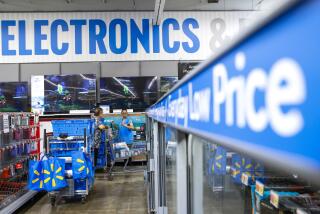Factory Orders Take Largest Jump Since ’70 : * Economy: The index of leading indicators also rises. The signs of growth cap a week of negative economic news.
- Share via
The U.S. factory sector appears to have churned forward at an extraordinary rate in July, in marked contrast to other signs of anemic economic activity, according to new government reports released Friday.
Factory orders rose 6.2% last month, the largest increase in more than 20 years, the Commerce Department reported. Separately, the index of leading economic indicators, the government’s key barometer for predicting the economy, jumped 1.2%, its sharpest advance in more than three years.
These reports bolster the view that the U.S. economy is now expanding, although the strength of recovery may be far less than the new statistics suggest, economists said Friday.
“The bottom line is that the industrial sector is picking up,” said David M. Jones, chief economist at Aubrey G. Lanston & Co., a securities firm in New York. “I wouldn’t rule out a double-dip recession,” he added. “But for now, at least, we’re on track.”
While pleased by the reports, analysts refrained from putting too much significance in them for a few reasons.
Data on factory orders are highly volatile month to month, and some questioned whether a seasonal quirk might have inflated the July statistics. Further, both government reports were heavily influenced by a jump in orders for big-ticket items known as durable goods. The jump was first reported last week.
“If these numbers we’re staring at are real numbers, we probably have a recovery going on,” said Robert A. Brusca, chief economist at Nikko Securities in New York. “But there’s ample reason to wonder.”
Orders for durable goods rose a booming 11.2% in July, a slight upward revision from last week’s report. Orders for “non-durable” goods, such as clothing, rose a modest 1.1%.
But other signals lately have been negative. In just the last few days, government reports on home sales, personal income and bank lending practices have underscored the fragile nature of the economy. Indeed, the Commerce Department this week backtracked on its earlier finding that the economy had burst out of recession during the spring--raising new questions about whether a recovery has taken hold.
Friday’s news provided a contrast to the bleak statistics. Factory orders have been rising at a “fairly nice” 2.4% average rate over the last four months, according to Michael L. Penzer, senior economist at the Bank of America in San Francisco. July’s 6.2% rise, however, is too strong to be sustained, he said. “It would signify some incredible type of economic boom, which is not occurring.”
It was the biggest rise in factory orders since December, 1970, when they gained 6.6%, and it followed a 1.2% decline in June.
The index of leading economic indicators, which sometimes--but not always--signals the economy’s direction several months down the road, was heavily influenced by a jump in orders for aircraft and other big-ticket items.
Orders for consumer goods, orders for new factory and business equipment and a rise in unfilled factory orders all propelled the forecasting gauge forward. Other positive factors included lower initial claims for unemployment insurance, rising stock prices and increased building permits.
The negative side featured flagging consumer confidence, a decline in the average workweek and a fall-off in the money supply when adjusted for inflation.
Are the factory gains for real? In a possible preview for the nation, a report by purchasing managers in the Chicago area released Friday showed robust activity in August--the first key indicator for the month.
Nonetheless, weaknesses in other sectors of the economy, such as home construction and employment, still point to a listless recovery, said Gary L. Ciminero, chief economist with the Fleet/Norstar Financial Group in Providence, R.I.
The overall picture suggests “the slowest post-World War II recovery on record,” he said.
Index of Leading Indicators
Seasonally adjusted index, 1982 = 100
July, ‘91: 145.4
June, ‘91: 143.7
July, ‘90: 146.2
Source: Commerce Department
Factory Orders
Total new orders in billions of dollars, seasonally adjusted
July, ‘91: 248.2
June, ‘91: 233.7
July, ‘90: 245.0
Source: Commerce Department
More to Read
Inside the business of entertainment
The Wide Shot brings you news, analysis and insights on everything from streaming wars to production — and what it all means for the future.
You may occasionally receive promotional content from the Los Angeles Times.










